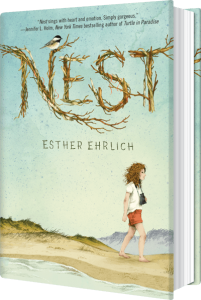
Esther Ehrlich, Author of Nest
Some things that I read make me long to meet the author. Anyone who can write like this, I think, must be a wise person. B. K. Loren’s novel Theft elicited that reaction. So did Elizabeth McCracken’s story, “Some Have Entertained Angels, Unaware” and “Welding with Children” by Tim Gautreaux. And now there’s this new book, Esther Ehrlich’s historical novel Nest, which I found myself magically pre-approved to download to my Kindle and read free-of-charge thanks to NetGalley (which provides complimentary e-books to reviewers and media people).
Set in the 1970s, Nest is a children’s book, purportedly for ages 10 and up, but it didn’t surprise me to learn that Esther didn’t plan it that way.
“I did not write the book with any audience in mind,” she told me recently while taping a radio interview for The Studio on KRUU-LP 100.1FM. “I really feel like I just wrote the book I really needed to write,” she explained.
Reading Nest, I wondered, Who could do this? Who could tell a story with so much sadness yet still infuse it with so much hope and joy? Nest’s protagonist, eleven-year-old Naomi (nicknamed Chirp due to her fascination with birds) faces serious problems. Her mom’s longstanding struggle to overcome crippling depression crumbles after troubling symptoms lead to a multiple sclerosis diagnosis and end her dancing career. The insistence of Chirp’s dad (a psychiatrist) on addressing family crises with emotionally insensitive discussions intensifies family members’ isolation. The family’s religion—they’re Jewish in an area where most people aren’t—renders evangelical Christian spiritual advice, offered awkwardly from secondary adults in Chirp’s life, irrelevant. Finally, Chirp’s friend Joey, whose home life includes physical and emotional abuse, develops obsessive compulsions.
Esther tempers all this malaise with graceful strategies that Chirp grasps for psychic survival: dancing indoors and out, tromping to her favorite birding-watching spots, throwing rocks with Joey in his secret, glass-walled hangout. Chirp’s life is filled with hit 1970s records and with the sounds of crickets and songbirds. She exploits all the freedom enjoyed by 1970s-era children, children untethered to technology, children who explore the landscape around them in a very visceral way. Esther plumbs all the richness of children’s lives during this less technological era.
Naomi reads books, and from one, Harriet the Spy, she learns the value of being observant. Nothing escapes this girl, not scents (sweat, lavender, lemon) or tastes (Oreos, Ring Dings, Yodels) or traditions (making menorahs by sticking candles into holes poked in raw potatoes, riding swan boats in the Boston Public Garden).
Enlivened by Chirp’s innocent engagement with the sensory world, readers eventually suspect that, aided by Joey’s friendship, this strong, thoughtful girl—though mightily challenged—will emerge from the blanket nest she’s built on her bedroom floor and navigate her way to a successful and happy adulthood.

Nest by Esther Ehrlich